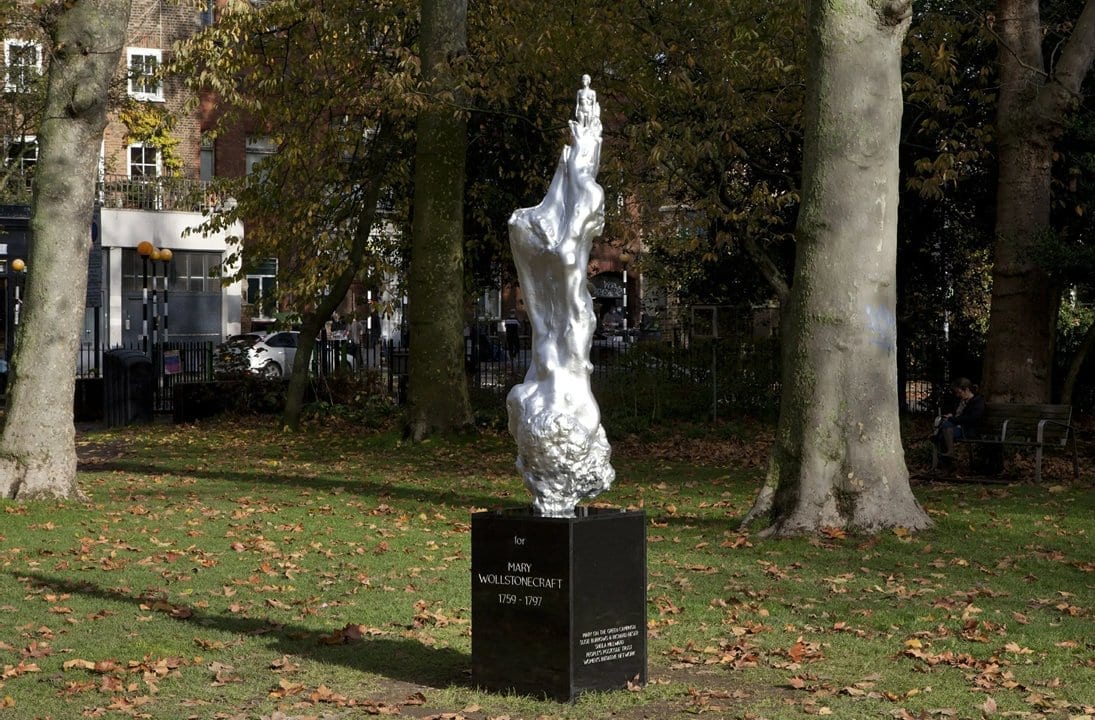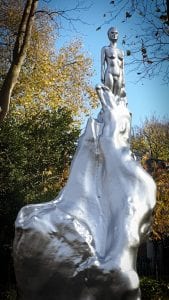On Tuesday 10th November, Maggi Hambling’s statue celebrating proto-feminist author Mary Wollstonecraft was revealed. Wollstonecraft’s eighteenth century book A Vindication Of The Rights Of Women, is hailed as one of the first feminist texts. In the book, one of Wollstonecraft’s lead arguments is that “taught from their infancy that beauty is woman’s sceptre, the mind shapes itself to the body, and roaming round its gilt cage, only seeks to adorn its prison.” The statue has evoked outcries that the chosen tribute only reinstates this damaging idea – that a woman’s value is defined by her physique.
Standing in a park in Islington, near where Wollstonecraft set up a school for girls, the silver toned statue towers above viewers. A naked female figure stands atop an indistinguishably shaped mass. Looking closer, the mass appears to be a mound of female forms; crucially, the figure is not a depiction of Mary Wollstonecraft (the sculpture, after all, is called ‘A Sculpture For Mary Wollstonecraft’, and not ‘of’). Instead, the figure is an ‘everywoman’.
The main criticisms were rooted in the claim that the figure’s nakedness makes her ‘sexually available’, thus undermining its dignity. There is a historic problem with hyper-sexualisation of the female body in art – exposed most famously by Guerilla Girls’ 1989 poster stating that 85% of nudes in the MET are female. But to claim that nudity automatically sexualises a figure is short-sighted.
Nudity does not equal sexuality. The female physical form exists outside of its ability to be sexually provocative. Yes, the figure may be naked, but it is not stood in a provocative stance. It stands tall and proud. There is a triumphant air about it; in classical Greek sculpture, nudity represented heroism. Stood on a silver mount, the figure has risen above this ‘gilt cage’.
Hambling herself said ‘statues in historic costume look like they belong to history because of their clothes‘. Hence the figure is nude because this statue should not belong to history; the campaign for women’s rights is not merely a part of history. The struggle continues today, and this figure celebrates the continuing path towards female bodily autonomy that Wollstonecraft influenced since her book was published in 1792.
I therefore refute that the physique indulges the male gaze. The figure is placed high up enough that it is far above comfortable viewing level. This, in addition to its small dimensions, emphasise how the main subject of the sculpture is the physical mound representing the issues women have had to overcome, and not the female physique.
I will concede that Hambling’s choice of a slim, athletic figure to portray ‘every woman’ has negative implications for the body positivity movement. In choosing the most classically desirable female body, she has given a stage to patriarchal beauty standards. Furthermore, Hambling’s bizarre defence that this is ‘what every woman wants to look like’ is not only an untrue statement, but it is also a cowardly one that shies away from any attempt to challenge the dangerous idea that ‘beauty is woman’s sceptre’.
However, I do not believe that the argument ‘this is not what every woman looks like’ is sufficient enough a point to condemn the piece. There is no universal female body type, so whatever other body type Hambling could have chosen would still not physically reflect all women. To refuse to interpret the figure allegorically, and yet care primarily about its distribution of body fat and muscle, has trans-exclusionary and ableist undertones.
Amongst the criticism of Hambling’s choice of a naked, conventionally attractive women as the subject of this piece, many are asking “why are male figures not commemorated like this?” Well for those familiar with Hambling’s work, they will recognise that this is not the case. Hambling’s ‘Memorial to Benjamin Britten’, a 13ft tall stainless steel sculpture of a scallop, bears even less resemblance to him than this physique does to Wollstonecraft.
Even if this were not the case, I still believe that this is the wrong question to ask. Frankly, I am quite bored of life-realistic statues of influential individuals because I believe that art should transcend physical representation and prompt discussion. Society would benefit from public art that is more about ideas and inspiration, and less about individuals. This statue will make the school children who walk past think longer and deeper about what femininity is than any bronze female figure in Georgian dress would.
It is true that there is a discrepancy in the number of public statues celebrating men and women – approximately only one in five monuments in the UK are of women – and there are multiple campaigns to amend this, but equal representation should not stall progression. Why should we hinder the interaction between art and the public, just to achieve an equal number of life-realistic statues of men and women? Can’t we close this gap with modern, exciting, debate-instigating art?
Society has progressed beyond the need for statues of literal likeness because we are past the age of putting people on pedestals. Those behind the campaign stress this, saying that the statue was created in opposition to ‘traditional heroic male statuary’. And so it should be: whilst radical for her time, we cannot praise Mary Wollstonecraft unconditionally because she did not advocate for the rights of all women. Classist attitudes, as well as a refusal to acknowledge the implications of a woman’s race, are woven into A Vindication Of The Rights Of Women.
Hambling’s sculpture is not perfect, but it is a fitting tribute. On the plinth is inscribed Wollstonecraft’s words: “I do not wish women to have power over men; but over themselves for women not ‘to have power over men; but over themselves’. The nude figure stood atop a mount of female body forms illustrates just that.
Words by Isabella Ward
Support The Indiependent
We’re trying to raise £200 a month to help cover our operational costs. This includes our ‘Writer of the Month’ awards, where we recognise the amazing work produced by our contributor team. If you’ve enjoyed reading our site, we’d really appreciate it if you could donate to The Indiependent. Whether you can give £1 or £10, you’d be making a huge difference to our small team.


